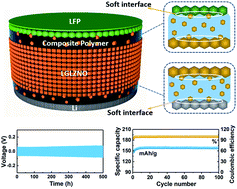Interfacial engineering facilitating robust Li6.35Ga0.15La3Zr1.8Nb0.2O12 for all-solid-state lithium batteries†
Abstract
All-solid-state lithium batteries are promising substitutes for traditional lithium ion batteries to solve the inherent safety issues of organic liquid electrolytes. However, the large interfacial resistance renders the batteries inefficient for practical applications. In this study, we have proposed a composite polymer/ceramic/composite polymer sandwiched electrolyte (CPCCPE), in which polyethylene oxide (PEO) is employed as the wetting polymer matrix on both the sides of CPCCPE, and a Ga and Nb co-doped garnet (i.e., Li6.35Ga0.15La3Zr1.8Nb0.2O12 (LGLZNO)), is used as the center of CPCCPE and also added into the PEO matrix to form the composite polymer. This battery architecture allows fluent lithium-ion transport across the interface and improves solid–solid interfacial contact, therefore resulting in increased ionic conductivity. Scanning electron microscopy (SEM), electrochemical impedance spectroscopy and galvanostatic charge/discharge (GCD) measurements demonstrate the effectiveness of this electrolyte configuration in enhancing the battery performance. The Li/CPCCPE/Li symmetrical cells exhibit stable plating/strapping properties over 500 h, and the constructed all-solid-state LiFePO4/CPCCPE/Li cells can maintain a high specific capacity (∼158 mA h g−1) after 100 cycles at 60 °C with coulombic efficiencies close to 100% during the long-term cycling process.



 Please wait while we load your content...
Please wait while we load your content...